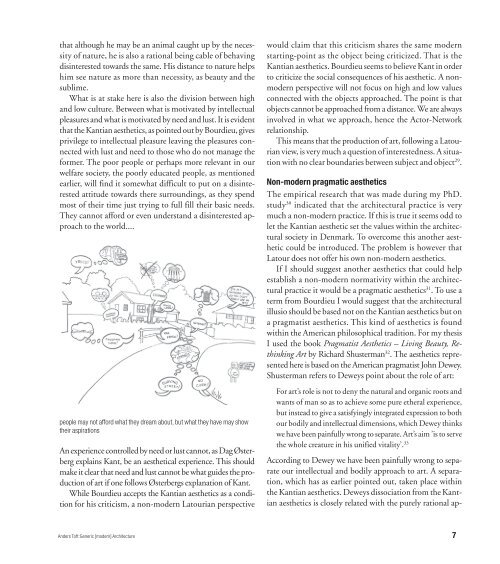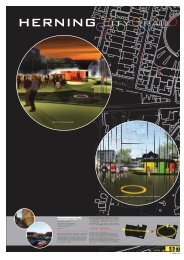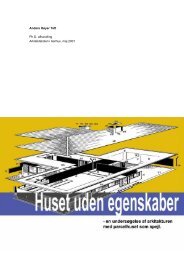art Anders Toft - Toft Arkitektur
art Anders Toft - Toft Arkitektur
art Anders Toft - Toft Arkitektur
You also want an ePaper? Increase the reach of your titles
YUMPU automatically turns print PDFs into web optimized ePapers that Google loves.
that although he may be an animal caught up by the necessity<br />
of nature, he is also a rational being cable of behaving<br />
disinterested towards the same. His distance to nature helps<br />
him see nature as more than necessity, as beauty and the<br />
sublime.<br />
What is at stake here is also the division between high<br />
and low culture. Between what is motivated by intellectual<br />
pleasures and what is motivated by need and lust. It is evident<br />
that the Kantian aesthetics, as pointed out by Bourdieu, gives<br />
privilege to intellectual pleasure leaving the pleasures connected<br />
with lust and need to those who do not manage the<br />
former. The poor people or perhaps more relevant in our<br />
welfare society, the poorly educated people, as mentioned<br />
earlier, will find it somewhat difficult to put on a disinterested<br />
attitude towards there surroundings, as they spend<br />
most of their time just trying to full fill their basic needs.<br />
They cannot afford or even understand a disinterested approach<br />
to the world....<br />
According to Dewey we have been painfully wrong to separate<br />
our intellectual and bodily approach to <strong>art</strong>. A separation,<br />
which has as earlier pointed out, taken place within<br />
the Kantian aesthetics. Deweys dissociation from the Kantian<br />
aesthetics is closely related with the purely rational appeople<br />
may not afford what they dream about, but what they have may show<br />
their aspirations<br />
An experience controlled by need or lust cannot, as Dag Østerberg<br />
explains Kant, be an aesthetical experience. This should<br />
make it clear that need and lust cannot be what guides the production<br />
of <strong>art</strong> if one follows Østerbergs explanation of Kant.<br />
While Bourdieu accepts the Kantian aesthetics as a condition<br />
for his criticism, a non-modern Latourian perspective<br />
would claim that this criticism shares the same modern<br />
st<strong>art</strong>ing-point as the object being criticized. That is the<br />
Kantian aesthetics. Bourdieu seems to believe Kant in order<br />
to criticize the social consequences of his aesthetic. A nonmodern<br />
perspective will not focus on high and low values<br />
connected with the objects approached. The point is that<br />
objects cannot be approached from a distance. We are always<br />
involved in what we approach, hence the Actor-Network<br />
relationship.<br />
This means that the production of <strong>art</strong>, following a Latourian<br />
view, is very much a question of interestedness. A situation<br />
with no clear boundaries between subject and object 29 .<br />
Non-modern pragmatic aesthetics<br />
The empirical research that was made during my PhD.<br />
study 30 indicated that the architectural practice is very<br />
much a non-modern practice. If this is true it seems odd to<br />
let the Kantian aesthetic set the values within the architectural<br />
society in Denmark. To overcome this another aesthetic<br />
could be introduced. The problem is however that<br />
Latour does not offer his own non-modern aesthetics.<br />
If I should suggest another aesthetics that could help<br />
establish a non-modern normativity within the architectural<br />
practice it would be a pragmatic aesthetics 31 . To use a<br />
term from Bourdieu I would suggest that the architectural<br />
illusio should be based not on the Kantian aesthetics but on<br />
a pragmatist aesthetics. This kind of aesthetics is found<br />
within the American philosophical tradition. For my thesis<br />
I used the book Pragmatist Aesthetics – Living Beauty, Rethinking<br />
Art by Richard Shusterman 32 . The aesthetics represented<br />
here is based on the American pragmatist John Dewey.<br />
Shusterman refers to Deweys point about the role of <strong>art</strong>:<br />
For <strong>art</strong>’s role is not to deny the natural and organic roots and<br />
wants of man so as to achieve some pure etheral experience,<br />
but instead to give a satisfyingly integrated expression to both<br />
our bodily and intellectual dimensions, which Dewey thinks<br />
we have been painfully wrong to separate. Art’s aim ’is to serve<br />
the whole creature in his unified vitality’. 33<br />
<strong>Anders</strong> <strong>Toft</strong>:Generic [modern] Architecture 7







